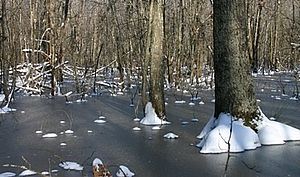Celebrate Wet Wonders on World Wetland Day

Winter is a great time to explore wetland areas that are otherwise inaccessible. Photo by USFWS.
February 2nd is World Wetlands Day, a day to raise public awareness about the importance and value of wetlands.
There are countless flooded forests, marshy swales, and peaty bogs throughout the Champlain Basin which help to prevent major floods from occurring downstream and provide important habitat for fish and wildlife. When torrents of spring snow melt come rushing out of the Adirondack or Green Mountains, rivers rage and lake levels rise. Rivers and lakes leave their normally disciplined beds, and spill water throughout the surrounding landscape. Wetlands then play the role of calming mediator. They accept the water and hold it serenely, relinquishing it back to the river over the course of days or weeks.
In calming and holding excess river water, wetlands do more than prevent floods; they also serve as traps for whatever debris the river carried and for whatever pollutants may have been clinging to the debris. As water leaves the banks of streams it loses energy and slows. Without energy, the water cannot carry its load of sediments. Larger particles are deposited close to the stream bank creating a sandy ridge or berm along the river shore. Water that passes over this sandy ridge is trapped behind the berm where finer sediments can settle out. In this way, silt that would have muddied the waters of Lake Champlain and carried a load of phosphorous to the lake is deposited in more upland settings.
Wetlands offer many benefits for people, but perhaps their greatest service is to wildlife. A host of fish, birds, and mammals depend on wetlands for all or part of their life cycle. Northern pike spawn in wetlands; waterfowl breed and mink hunt frogs and fish in marshy areas. Animals are attracted by the abundance of food and cover in wetland areas. Furthermore, since few people are willing to wade through thigh deep water with a swarm of biting flies around their head, wetlands provide animals a refuge from human encroachment.
In the past wetlands were condemned as nothing more than wastelands and breeding grounds for mosquitoes. In fact, approximately 60% of the wetlands in New York State and 50% of Vermont wetlands have been lost or impaired, often converted to other uses such as agriculture or development. However, over the past few decades, society has finally begun to recognize the value of wetlands for flood control, pollution control, and wildlife habitat.
So take advantage of World Wetlands Day. Get out into a wetland near you for exploration, photography or wildlife tracking. Wherever you live in the Champlain Valley there is a wetland near you. Here are a few places to visit:
Missisquoi National Wildlife Refuge – Swanton, VT
Delta Park – Colchester, VT
Dead Creek – Addison, VT
Ausable Marsh – Peru, NY
Monty’s Bay – Beekmantown, NY
East Bay – Whitehall, NY
